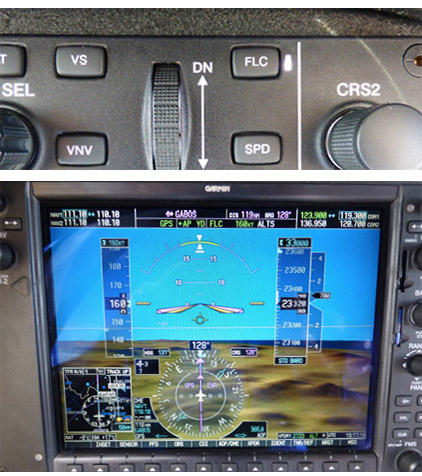 Using FLCH and VS
Using FLCH and VS
Pilots have some options when it comes to managing climbs—be they initial climbs after takeoff or en route climbs to a cruising altitude. You can fly manually, of course, but standard practice is to use the autopilot/integrated flight control system. Let’s face it: These systems fly more accurately and smoothly than we can.
Perhaps the most popular method is to use an automated system’s flight level change feature, labelled FLC or FLCH on the glareshield control panel. “Filch” lets you select a climb speed; rotate the selector knob until you reach the indicated airspeed you want. For light jets such as the Cessna Citation Mustang or Embraer Phenom 100, a typical initial climb speed is 160 knots. En route climb speeds are in the 190- to 200-knot range. You set the speeds and the airplane pitches up to capture and hold it on your way up. Simple?
Yes, but as you climb into the 20s, you’ll find that you’ll have to slow your FLCH speed so you can preserve a decent climb rate. And there’s a potential problem with that. The higher you go, the slower you’ll be. The angle of attack will increase, and your margin against the stall will narrow as the air gets progressively thinner.
That’s why some experts recommend changing from FLCH to VS (vertical speed) mode before you begin filching yourself into stall country. Flying a constant pitch setting—say, 5 degrees nose-up in a light jet—will keep you climbing and protect you from a stall. You’ll have to adjust the pitch as you climb, of course, but at 5 degrees nose-up, you’ll find your airspeed pretty much matching any recommended FLCH values. Just beware pitching up any more than 8 or so degrees. At higher altitudes, the airplane may stall.
Climbing at 3 to 5 degrees nose-up should keep you away from the stall—assuming no wild turbulence or steep banks—while still optimizing your ability to climb, which of course will dwindle the higher you go. As you get near your ceiling, the airplane’s climb rate may be down to a paltry 100 fpm. Or worse, there’s no climb at all! Maybe the temperature’s too high, or your weight is penalizing you. But at least you’re not stalling. Consider this a hint: You’ve finished climbing, captain! You’ve found your ceiling, and a lower altitude is the way to go.
Finance
Do you need an engine program?
Financing may be a factor
Turbine aircraft ownership comes with new and unique maintenance and management considerations. Among them: engine programs. Essentially a contract engine reserve fund, engine programs enable you to reduce risk, spread out big maintenance bills, and potentially simplify engine maintenance with a regular payment schedule. Sounds great, right?
In many cases an engine program can be a good thing, but these programs are not for everyone. Consider that the company offering the program needs to make a profit, which means you’ll likely pay more for a program than if you go it alone. However, engine programs can have other benefits, such as shorter downtimes and better access to maintenance service.
There is one big caveat when deciding whether or not to buy an engine program. Because a lender needs to protect its collateral, and a jet without engines is not worth nearly as much as one that’s flying, many lenders require an engine program, said Adam Meredith, president of AOPA Aviation Finance. “It all depends on the airplane, the lender, and the strength of the borrower,” he explained.
So does that mean sucking up the cost and buying into an engine program if you are financing the jet? Not necessarily, Meredith said. “If you are adamant not to do a program, we may be able to get a financing deal done. That said, there are certain aircraft/engines where virtually everyone uses an engine program.” Meredith said AOPA Aviation Finance understands pilots and their unique needs, and acts on their behalf to get the type of deal they want. “Let us go to the lender and do this for you,” he said.
To learn more or to start an application, visit AOPA Aviation Finance online.
AOPA Aviation Finance coverage sponsored by Aero-Space Reports



